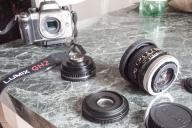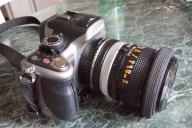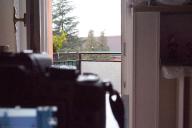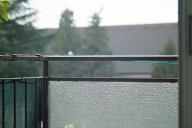
-
Hey guys, first post here, but I followed the discussion for quite a while last year. Basically I'm trying to figure out if the blue dot issue should deter me from getting the RJ.
I've seen all sorts of claims around, that is an RJ issue, that is a individual lens issue, that it happens when you stop down, that it happens all the time, etc. Has anyone anywhere actually systematically documented when exactly the blue dot happens?
Also see some people talking about a second version of the adapter? Is that an RJ version or some other brand?
Looking to get a Nikon F >>>> m43 one.
-
Hi guys i have black magic pocket and set of yashica ml lenses Metabone is to expensive for me and i heard about RJ Lens Turbo Booster do they make it for yashica ml lenses i believe its its C/Y mount and where can i buy one cant find it any where and is ti as good as metabone
Thanks guys
-
"What is the lens you used? As thing called blue dot is actually happening due to reflections and is dependent on the lens used. It was a Nikon 35mm AI at the time."
Central hotspots with focal reducers almost always involve a reflection from the sensor followed by a reflection from one of the lens surfaces within the reducer. The attached master lens plays a role only in that it determines the exit pupil location, which can make a big difference in hotspot definition and brightess. Explanations involving the AR coating quality of the master lens are very doubtful. The RJ reducer in particular has a well-documented issue with exit pupil distance around 109mm, which results in a very sharply focused blue-green ghost image. As the exit pupil distance is reduced the ghost image becomes less defined, but more intense blue in color. Note that the exit pupil is the image of the aperture stop as seen from the rear of the lens, and is completely unrelated to focal length.
-
Thanks, will do!
-
Thing is, you talk about Canon FD lenses and they are different and slightly weird.
Type "adapter play" and you'll get best results on top.
Like http://www.personal-view.com/talks/discussion/52/how-to-fix-lens-to-adapter-looseness/p1
-
The play was my bad, no play anymore. I still don't understand why I have to lock the lever/pin on the lens, then attach to the adapter and then switch to lock on the adapter. I haven't read any comments or experiences about that here. And the FD Kenlock lens is even stranger: I have to keep the switch to open in order to work, but it only works from wide open (2.8) untill 5.6 max.
If this is not the proper place for this question I will delete it.@vitaliy_Kiselev do you mean search this topic or am I missing a link?
-
It doesn't fit too tight, there is al little play
Adapter or lens on the adapter has some play?
You can search here for solution for adapters (quite old topic, but good one).
-
Hi everyone,
Recieved my RJ adapter (FD) within two weeks (I live in the Netherlands). It looks very good, and now I'm doing some testing. It doesn't fit too tight, there is al little play, I will have to look up how I can fix that. I couldn't get the aperture to work, it was stuck wide open. Untill I found out that I have to push the lever for the aperture on the back of the lens al the way untill it "stuck". Then screw it in the adapter and then set the adapter to lock. Is this a normal procedure for this adapter? It works with my Canon FD lenses but I also have a Kenlock lens and with this lens the lever can not be locked. I don't have another normal FD to m43 adapter so I can't compare the shots, but so far the images look very nice. Okay, my experience so far :) Tips are always welcome.
-
It was a Nikon 35mm AI at the time.
Got it. Usually the more modern lens is used - the better is result, as coating of rear element in modern lenses in made for very reflective sensor.
-
What is the lens you used? As thing called blue dot is actually happening due to reflections and is dependent on the lens used.
It was a Nikon 35mm AI at the time.
-
After shooting with this adapter in bright conditions where I was stopping down to f/8-f/11, the blue dot is so bad that the footage is almost unusable.
What is the lens you used? As thing called blue dot is actually happening due to reflections and is dependent on the lens used.
-
After shooting with this adapter in bright conditions where I was stopping down to f/8-f/11, the blue dot is so bad that the footage is almost unusable. I suppose I could make a LUT or powergrade that color corrected the dot region and apply it to the entire timeline....
-
Send me PM with link to photo (not huge)
-
Hi, same problem as Bernie. The tensioner ring is broke. Although I have shaved the rear aperture lever. I removed the tensioner ring. Is it essential?
-
works better or worse, but depending by the aperture (see last three pictures) I have only done this test ... I was surprised but it works ...
-
So Maximizer, FD to RJ EOS worked fine for you? no wobble?
-
experimental Panasonic GH2 > Rj turbo Eos to M4/3 > Cheap adapter Fd to Eos ( with lens)> canon Fd 50 f1.4 scc

 _1010509.jpg600 x 401 - 264K
_1010509.jpg600 x 401 - 264K
 _1010516.jpg600 x 401 - 270K
_1010516.jpg600 x 401 - 270K
 _1010519.jpg600 x 401 - 228K
_1010519.jpg600 x 401 - 228K
 _1000172.jpg800 x 533 - 355K
_1000172.jpg800 x 533 - 355K
 _1000173.jpg800 x 533 - 358K
_1000173.jpg800 x 533 - 358K
 _1000177.jpg800 x 533 - 445K
_1000177.jpg800 x 533 - 445K -
@texpic wrote me some questions regarding the RJ after I have it for almost a year now (I participated in this thread earlier, around March '14). Anyways, he thought it might be beneficial for all so I'll just copy my answer to him:
Regarding the blue flare. I now was able to get it into the image, but that was only when I stopped down a lot, I think we were at f/8 or f/11. That's something I knew before, but at that day I simply forgot the NDs at home (as it wasn't an important shoot I didn't really care too much). Usually I wouldn't go to f/11 or so anyway, as I'd rather use a Lens without a Turbo in that case (if I want to stop down really hard there's no reason for an additional stop of light). Anyway, I "recently" bought a cheaper competitor from eBay, 70€ or so, and then I understood why people have a big deal with the blue dot: it happened a lot. Here's an example I uploaded some time ago, RJ vs the other one: https://www.dropbox.com/s/19xdf08ilbxiycp/rj-lengril-comparison.jpg?dl=0 That was wide-open, not stopped down a lot, on a Tokina 11-16mm (no idea which focal length)
Putting a Nikon->EF Adapter on top of the EF Turbo was something I tried, but in the end it's not really a beneficial combo. Maybe my NIK-EF Adapter is bad, but it simply intoduces a lot of wobble. This is, at best, only a temporary fix. That's actually the reason I bought the cheap adapter I told you about, because I wanted a native Nikon one (but save a bit of cash at that end). What I noticed it, it isn't worth to buy a cheaper Turbo (and the difference is only 30€ or so), and it seems that it isn't worth to get only one Turbo if you need Nikon+Canon. OM, Pentax, M42 - those adapters fit fine on the EF Turbo, and that works out. Simply because the adapters are generally a bit better and thicker. But the thin Nikon Adapters aren't that good for this. I know that the additional cost of a 2nd Turbo can be a problem for some, but in the end you are still cheaper with two Turbos in comparison to one Speedbooster... :)
Hope it helps out one or another
-
He wasn't talking about putting a m4/3 lens on an E-Mount camera, though. He wanted to do the opposite.
-
This is to put a MFT lens on an Emount camera with an adapter.
I don't own anything in E mount, but, bought on Amazon an E mount (cam mount) to MFT (lens mount) adapter. I recall that emount is a shorter FFD than MFT mount. The FAQ supports this: http://www.personal-view.com/faqs/camera-usage/lenses-mounts-faq
I bought one made by Fotodiox on Amazon. It looks like this generic one: http://www.amazon.com/NEEWER%C2%AE-Micro-Olympus-Sony-Adapter/dp/B00DSGLZWA/ref=sr_1_1?ie=UTF8&qid=1421280554&sr=8-1&keywords=MFT+m4%2F3+lens+to+Sony+NEX+adapter
Be aware that many adapters are made to guarantee infinity focus and therefore are made too short (so infinity is at say 10' on the lens scale). Stacking adapters, especially behind a speedbooster may yield focus issues.
-
So first let me say YES I HAVE READ THIS ENTIRE THREAD.
I am going to re-ask several questions that have already been discussed to see if anyone has CHANGED their minds due to LONGER TERM experience with these RJ adapters. Sometimes with more experience comes more wisdom ;-).
So do you still feel the blue flare incidence is tolerable? - i.e. it hasnt gotten on your nerves over time or occurred more frequently than thought?
Over time has it worked acceptably to do: Nikon F lens => nikon to canon adapter ring => canon EF RJ adapter ( to just buy one RJ)? I know some people seemed to be fluctuating pro/con on this? Or just bite the bullet and buy multiple RJs?
Please dont suggest i reread the thread (or links) - i am now asking for comments based on LONGER TERM USE.
-
@aldolega well that makes sense. I had no idea. Thank you!
-
I don't think there is such a thing as an E-mount to m4/3 adapter, as E-mount's flange distance is shorter than m4/3's.
-
Hi everyone, I'm looking to get a focal reducer and I had a question. I'm sorry if this has been addressed before in this thread.
So I'm planning on purchasing a sony a7s to complement my gh4. I'm trying to plan my budget and I'd like to get a focal reducer. I was wondering if I should/would be able to get a single focal reducer (say an FD to Sony E) and then get a cheap Sony E to M4/3 adapter to use it on my gh4. Would the focal reducer still be as effective as an FD to m4/3 in this case?
Or should I just get an exclusive focal reducer for each mount? Thanks!
-
On nikon lenses with/without aperture ring at f/2.8, the maximum opening is only at the equivalent of f4 if you use the adapter's aperture ring instead of the lens' maximum (f/2.8 for the present exemple). Is that normal ?
It depends on specific adapter (as with time they are modified fixed) and specific lens. You need to check how mechanical lever moves.
On the adapter'aperture ring, there's no indications for the iris opening (f1, f2.x, etc). Is there a way to compensate for this ?
If you think a little and look at different lenses and their lever, you understand that it can't be done on adapter side.
Howdy, Stranger!
It looks like you're new here. If you want to get involved, click one of these buttons!
Categories
- Topics List23,990
- Blog5,725
- General and News1,353
- Hacks and Patches1,153
- ↳ Top Settings33
- ↳ Beginners256
- ↳ Archives402
- ↳ Hacks News and Development56
- Cameras2,367
- ↳ Panasonic995
- ↳ Canon118
- ↳ Sony156
- ↳ Nikon96
- ↳ Pentax and Samsung70
- ↳ Olympus and Fujifilm101
- ↳ Compacts and Camcorders300
- ↳ Smartphones for video97
- ↳ Pro Video Cameras191
- ↳ BlackMagic and other raw cameras116
- Skill1,960
- ↳ Business and distribution66
- ↳ Preparation, scripts and legal38
- ↳ Art149
- ↳ Import, Convert, Exporting291
- ↳ Editors191
- ↳ Effects and stunts115
- ↳ Color grading197
- ↳ Sound and Music280
- ↳ Lighting96
- ↳ Software and storage tips266
- Gear5,420
- ↳ Filters, Adapters, Matte boxes344
- ↳ Lenses1,582
- ↳ Follow focus and gears93
- ↳ Sound499
- ↳ Lighting gear314
- ↳ Camera movement230
- ↳ Gimbals and copters302
- ↳ Rigs and related stuff273
- ↳ Power solutions83
- ↳ Monitors and viewfinders340
- ↳ Tripods and fluid heads139
- ↳ Storage286
- ↳ Computers and studio gear560
- ↳ VR and 3D248
- Showcase1,859
- Marketplace2,834
- Offtopic1,319







